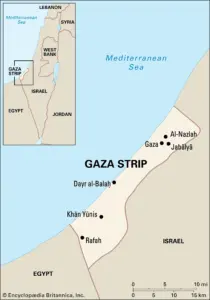
THE CITY OF GAZA
The city of Gaza, located in the coastal region southeast of present-day Israel, is a place of great historical significance that dates back to antiquity and the beginning of civilizations. It has been mentioned in the Bible as a witness to multiple stages throughout millennia; therefore, through biblical texts, as well as archaeological evidence and extra-biblical references, we can trace its history. In this article, we explore its early mentions in the Bible up to the period of British domination.
One of the earliest accounts where it is mentioned is in the book of Genesis 10:19, as one of the cities of the plain, along with Sodom, Gomorrah, Admah, and Zeboim, primarily inhabited by the Canaanites. Later, in Genesis 26:1, a famine in the land is referenced, during which Isaac moved to Gerar, which was near Gaza. However, it is in the historical books of the Bible, such as Joshua and Judges, where Gaza gains greater relevance. In Joshua 10:41, it is mentioned that Joshua took Gaza as part of the campaign to conquer the Promised Land. Then, in Judges 16, the conflicts between the Israelites and the Philistines, a people who settled in that region, are recounted. One of the most famous episodes is the story of Samson and Delilah, which takes place there in Gaza.
Who were these Canaanites? Recent studies indicate that the Canaanites were polytheistic and idolatrous people, who in some cases went so far as to perform human sacrifices. And although it seems they disappeared in history, their genes are mainly found among the Lebanese today. The Bible identifies the Canaanites throughout the western coastal zone of the Mediterranean, coinciding with the land promised by God to Abraham.
Where did the Philistines come from? This people grew through the occupation of Aegean civilizations, which were seafaring peoples from the Mediterranean who settled there through trade and colonization in those years when Israel was also conquering the area after their return from Egypt. As they were sailors and Israel came from forced labor slavery unrelated to these trades, it was very easy for the Philistines to settle in the coastal strip. Their main cities were Gaza, Ashkelon, Ashdod, Gath, and Ekron. Once Israel grew and developed, they became antagonistic, unlike other peoples in the region who always maintained relations with Israel. However, the Philistines in Gaza came to their end not by the hand of Israel but by the expansion of the Assyrian Empire in the region in the 8th century BC. The Assyrian conquest and the deportation of entire populations marked the decline of Philistine culture. Although some elements of Philistine culture may have survived in the region, it no longer existed as an independent political entity. After the fall of the Assyrian Empire, Gaza came under Persian rule during the Achaemenid period and then under the Hellenistic Empire of Alexander the Great, wiping out what little remained of its culture.
Precisely because of this historical antagonism with Israel and also because they no longer existed, Emperor Hadrian chose in 135 AD, after three years of Jewish rebellion, to change the name of Judea to Palestine for the entire region.
In the late 4th century, the Roman Empire divided into East and West, and Palestinian Gaza came under the dominion of the Byzantine Empire, becoming an important Christian center. Three centuries later, Gnostic Christianity gave birth to Islam, a new religion that spread very quickly throughout the region through the forced conversion of every place they reached, using the same methods that we classify as the bloodiest terrorists today. Of course, this was not exclusive to them, as the Crusaders did the same. And without wanting it, the city of Gaza passed from Muslims to Crusaders and back again, suffering for centuries from this transfer in the midst of a bloody culture always in the name of a God.
It is worth clarifying once again in the midst of this series of articles on the current Palestinian situation that the region never ceased to have Christians and Jews, as according to the Quran both are people of the book and should not be forced to convert to Islam. However, when seen as unjust, they can and should be eliminated. If the ruling Muslim government considers them peaceful and docile, they can tolerate them with total limitations, but if they cannot accept those limitations, they should be eliminated in the most exemplary and deplorable way possible.
Subsequently, Gaza was part of the Ottoman Empire from the 16th century to the early 20th century, which has entirely defined the worldview and almost totalitarian religion of its inhabitants to this day. After World War I, Gaza came under the British Mandate of Palestine, as mentioned in previous articles, until 1948. After World War II and the founding of the State of Israel, Gaza came under Egyptian control, but after the Six-Day War in 1967, it came under Israeli occupation. In 2005, due to terrorist attacks, Israel withdrew its forces from the city and established a blockade on Gaza. In 2007, the United States promoted democratic elections there, and incredibly the terrorist group Hamas took control of the Gaza Strip, and since then has used all the power coming from the city (international donations and foreign investments) to develop an army that could return to the fight against Israel.
The city of Gaza has witnessed countless changes over the centuries, from its mention in the Bible to its evolution through different empires and civilizations. Its history is a testament to the complexity and importance of the region in which it is located.
To be continued…
Author: Dr. Liber Aguiar
0 Comments